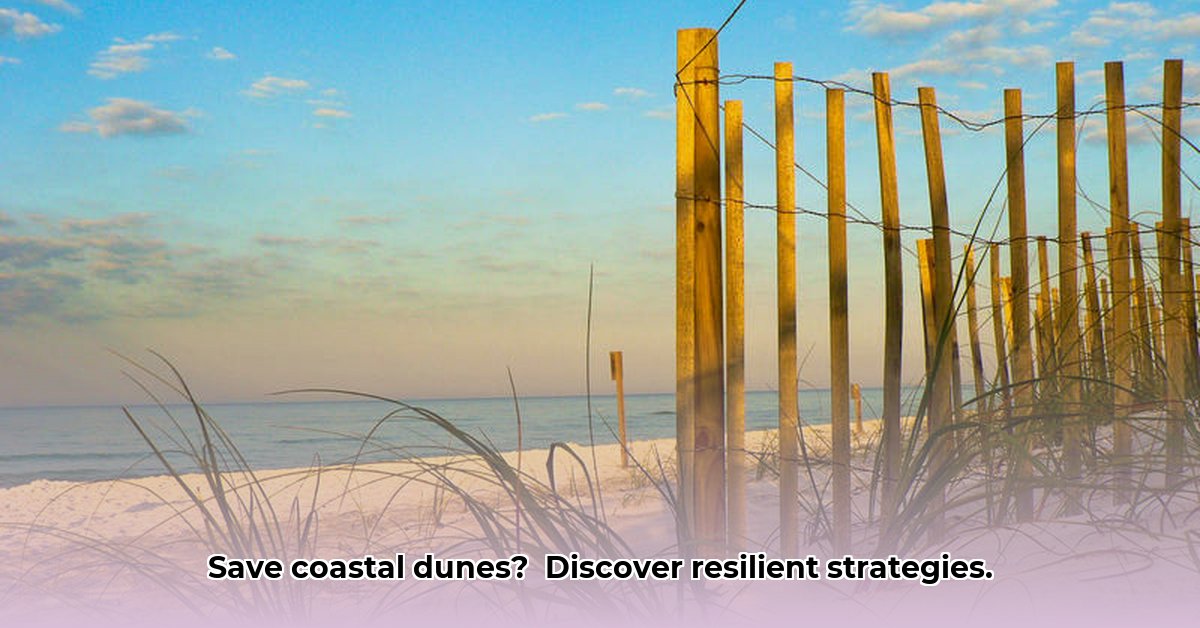
Coastal dunes are vital natural barriers protecting our coastlines. However, rising sea levels and human impact threaten their stability. This guide provides effective strategies for coastal dune plant management, ensuring these ecosystems thrive for future generations. We'll explore plant selection, planting techniques, and collaborative approaches, addressing common challenges and fostering resilience in the face of climate change. Learn more about American beachgrass, a common dune stabilizer, here.
Understanding Coastal Dune Ecosystems
Coastal dunes are dynamic ecosystems, constantly shaped by wind and waves. Plants are key to their stability, anchoring the shifting sands and creating habitats for diverse wildlife. Different plant species thrive in various dune zones, from the exposed foredunes to the more sheltered back dunes. Understanding these zones is crucial for effective plant selection. Choosing the right plants is akin to building a resilient team, each member playing a vital role in maintaining the dune's health.
Selecting the Right Plants: A Coastal Dune Species Guide
Plant selection is paramount for successful dune restoration. The best choices depend on your specific location's climate and soil conditions. Native species are generally preferred, offering superior adaptation and ecosystem support.
Popular Dune Plants: Benefits and Considerations
American beachgrass (Ammophila breviligulata) is widely used for its rapid sand-trapping ability. However, its invasive potential requires careful management. Sea oats (Uniola paniculata) provide excellent stabilization and support wildlife, representing a more balanced choice. Other native species, like Ipomoea pes-caprae (beach morning glory) and Hibiscus pernambucensis (Brazilian hibiscus), contribute to diversity and aesthetic appeal, but their specific needs (sunlight, soil drainage) should be considered carefully. Choosing diverse plant communities creates stronger, more resilient dunes. Shouldn't we prioritize biodiversity for long-term success?
A Step-by-Step Planting Guide for Coastal Dune Restoration
Effective planting involves careful planning and execution. Here's a step-by-step approach:
- Site Assessment: Thoroughly examine your chosen site. Note existing vegetation, soil type, sun exposure, and wind/wave exposure. This assessment informs your plant selection and planting strategy.
- Plant Selection: Choose native species suited to your site's conditions. Consult local nurseries or conservation organizations for guidance. Prioritizing locally sourced plants ensures superior adaptation and minimizes costs.
- Planting Technique: Follow best practices for planting, ensuring proper spacing to prevent overcrowding and competition.
- Ongoing Maintenance: Treat dune planting as a long-term project. Regular monitoring, watering (especially during dry spells), weeding, and addressing erosion are essential for long-term success. Maintaining healthy dunes isn't a one-time effort; it's a continuous commitment.
Collaborative Approaches for Effective Dune Management
Successful dune management requires collaboration among various stakeholders:
| Stakeholder | Role |
|---|---|
| Coastal Communities | Responsible land stewardship; supporting restoration projects; respecting access guidelines. |
| Land Managers | Developing and implementing planting plans; overseeing maintenance; monitoring dune health. |
| Environmental Agencies | Enforcing regulations; providing funding for research and restoration; public education. |
| Researchers | Conducting studies; analyzing long-term effects of management strategies; guiding best practices. |
This collaborative effort ensures comprehensive dune protection and promotes effective resource utilization.
Addressing Challenges and Adapting to Climate Change
Limited funding and complex regulations are common challenges. Innovative solutions, such as community partnerships and grant applications, can mitigate these. Climate change poses further challenges, including rising sea levels and more intense storms. Choosing climate resilient plant species, those tolerant of saltwater intrusion and extreme weather, is vital for future-proofing our dunes. Adaptive management, continuously adjusting strategies based on ongoing research and monitoring, is crucial for long-term success. How can we ensure our dune management strategies remain relevant in a changing climate?
Frequently Asked Questions (FAQ)
- Q: What if my budget for coastal dune restoration is limited? A: Prioritize high-impact areas, explore volunteer assistance, and seek out grant opportunities.
- Q: How can invasive species be effectively managed? A: Regular monitoring, early detection, and swift removal are key strategies.
- Q: Where can I find additional information and resources on coastal dune management? A: Contact your local coastal conservation agency, university extension office, or reputable environmental organizations.
This guide offers a framework for effective coastal dune plant management. Always consult with local experts and adhere to relevant regulations before initiating any restoration project. The health of our coastal dunes is an investment in our future, providing critical protection for our communities and invaluable biodiversity. Let's work together to preserve these vital ecosystems.